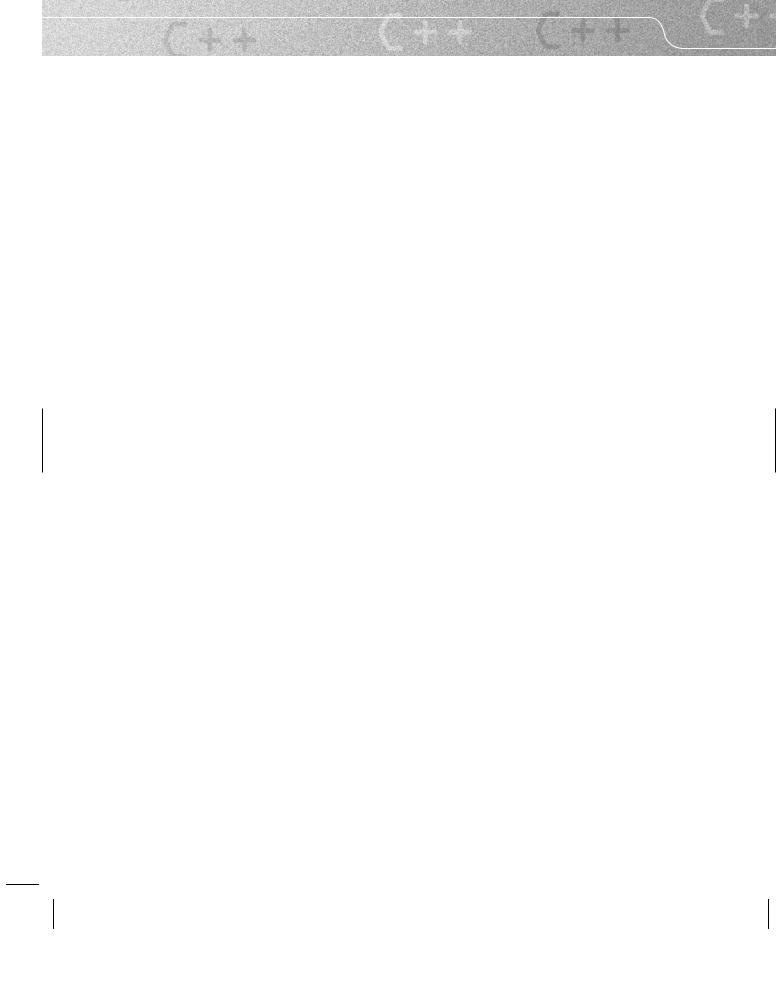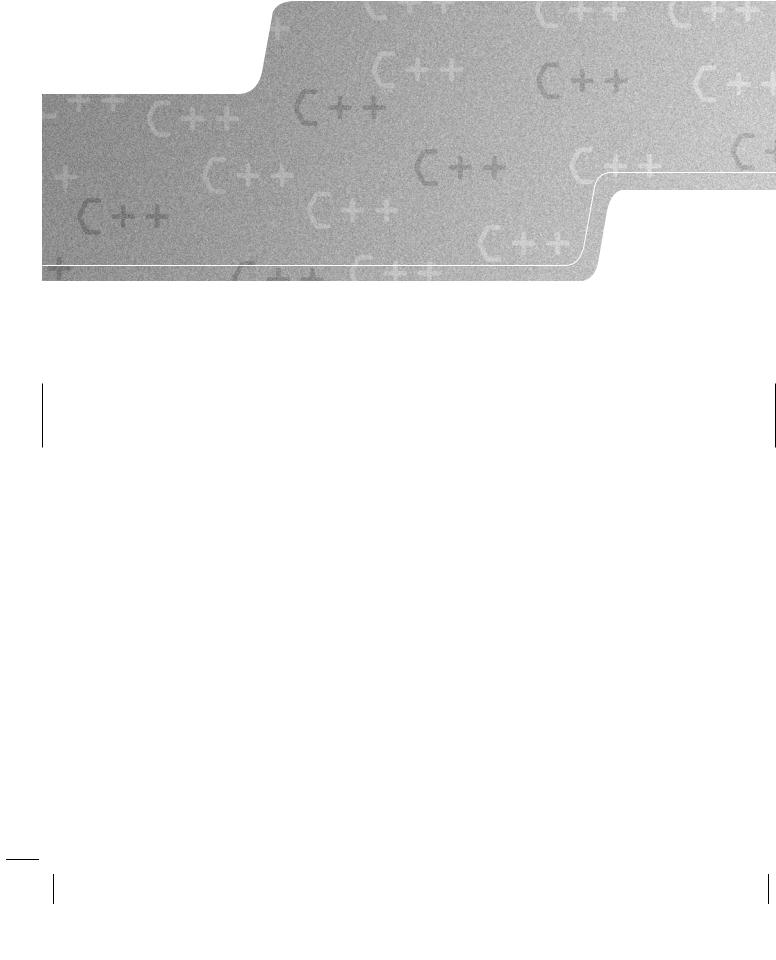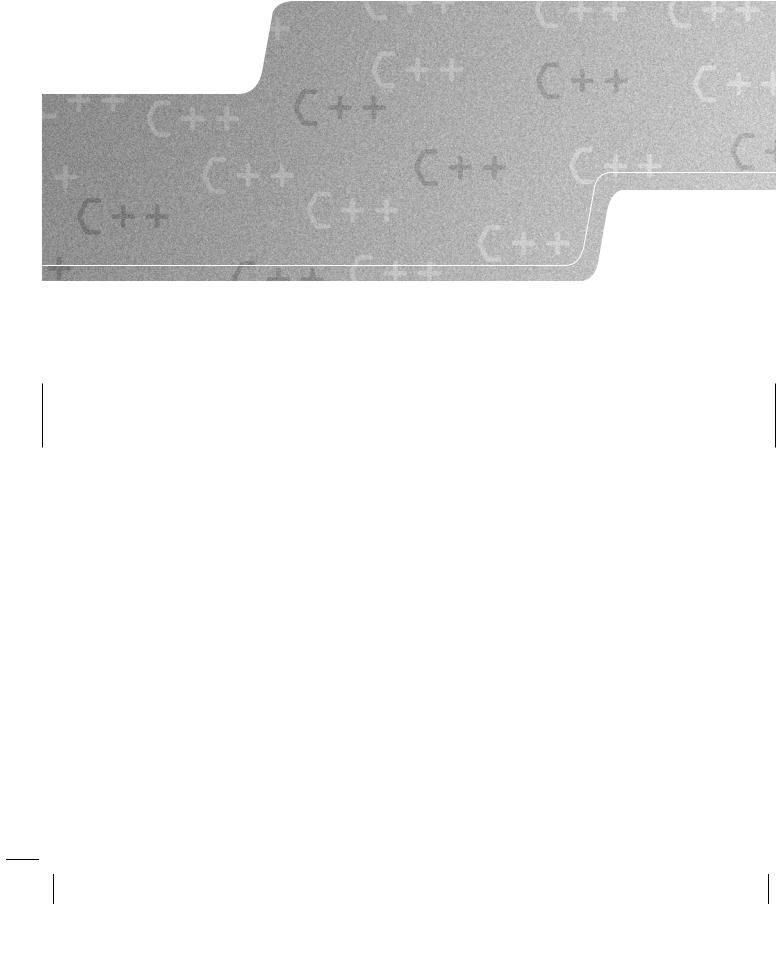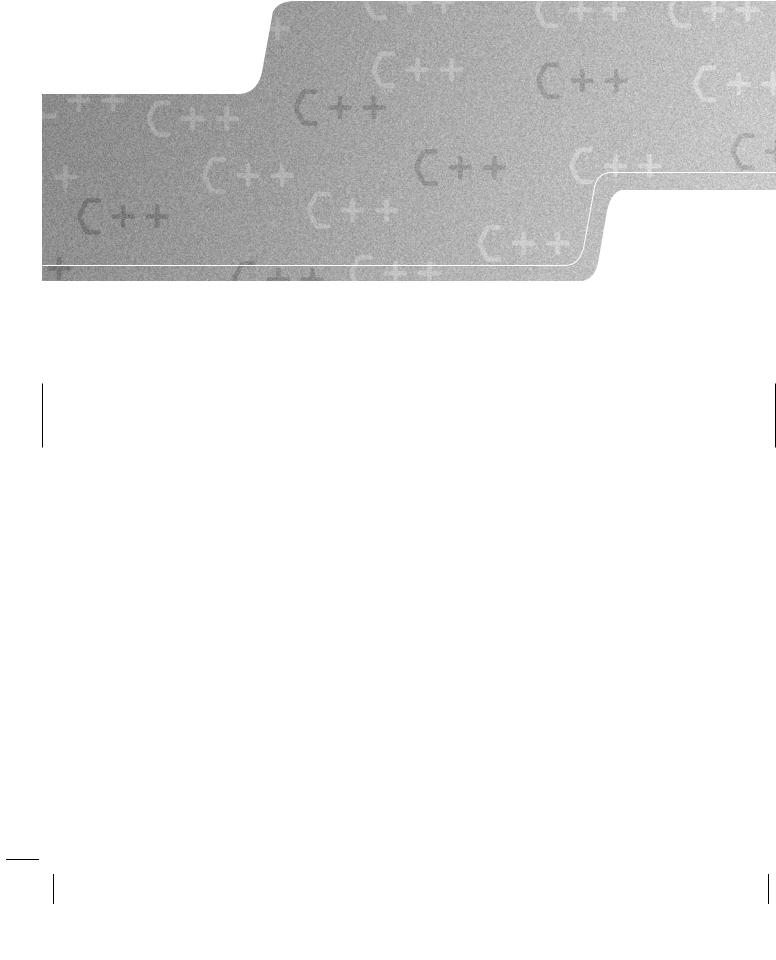
You Can Program In C++ (2006) [eng]
.pdf
viii CONTENTS
|
Something to Play With . . . . . . . . . . . . . . . . . . . . . . . . . . . . . . . . . . . . . . . . |
21 |
|
Summary . . . . . . . . . . . . . . . . . . . . . . . . . . . . . . . . . . . . . . . . . . . . . . . |
21 |
2 |
Fundamental Types, Operators, and Simple Variables . . . . . . . . . . . . . . . . . . . . . . |
23 |
|
A Simple Program . . . . . . . . . . . . . . . . . . . . . . . . . . . . . . . . . . . . . . . . . . . |
23 |
|
What Is a Type? . . . . . . . . . . . . . . . . . . . . . . . . . . . . . . . . . . . . . . . . . . . . |
24 |
|
What Are Fundamental Types? . . . . . . . . . . . . . . . . . . . . . . . . . . . . . . . . . . . . |
25 |
|
Representing Negative Integers . . . . . . . . . . . . . . . . . . . . . . . . . . . . . . . . . . . . |
26 |
|
Derivative Types . . . . . . . . . . . . . . . . . . . . . . . . . . . . . . . . . . . . . . . . . . . . |
27 |
|
Declaration and Definition . . . . . . . . . . . . . . . . . . . . . . . . . . . . . . . . . . . . . . . |
28 |
|
Names in C++ . . . . . . . . . . . . . . . . . . . . . . . . . . . . . . . . . . . . . . . . . . . . . |
28 |
|
Operators . . . . . . . . . . . . . . . . . . . . . . . . . . . . . . . . . . . . . . . . . . . . . . . |
29 |
|
A Simple Program . . . . . . . . . . . . . . . . . . . . . . . . . . . . . . . . . . . . . . . . . . . |
30 |
|
Exceptions – Handling Bad Input . . . . . . . . . . . . . . . . . . . . . . . . . . . . . . . . . . . |
31 |
|
Writing Correct Code . . . . . . . . . . . . . . . . . . . . . . . . . . . . . . . . . . . . . . . . . |
32 |
|
Getting Output Before Handling an Exception . . . . . . . . . . . . . . . . . . . . . . . . . . . . . |
33 |
|
A Little More About Playpen . . . . . . . . . . . . . . . . . . . . . . . . . . . . . . . . . . . . . . |
34 |
|
Default Playpen Color Names . . . . . . . . . . . . . . . . . . . . . . . . . . . . . . . . . . . . . |
36 |
|
Characters and Text . . . . . . . . . . . . . . . . . . . . . . . . . . . . . . . . . . . . . . . . . . |
37 |
|
Floating-Point Numbers . . . . . . . . . . . . . . . . . . . . . . . . . . . . . . . . . . . . . . . . |
39 |
|
First Floating-Point Program . . . . . . . . . . . . . . . . . . . . . . . . . . . . . . . . . . . . . . |
39 |
3 |
Looping and Making Decisions . . . . . . . . . . . . . . . . . . . . . . . . . . . . . . . . . . |
51 |
|
Some Library Types . . . . . . . . . . . . . . . . . . . . . . . . . . . . . . . . . . . . . . . . . . |
51 |
|
Making Decisions . . . . . . . . . . . . . . . . . . . . . . . . . . . . . . . . . . . . . . . . . . . |
53 |
|
Looping . . . . . . . . . . . . . . . . . . . . . . . . . . . . . . . . . . . . . . . . . . . . . . . . |
58 |
|
On Magic Numbers . . . . . . . . . . . . . . . . . . . . . . . . . . . . . . . . . . . . . . . . . . |
65 |
4Namespaces and the C++ Standard Library . . . . . . . . . . . . . . . . . . . . . . . . . . . . 71
Wide Versus Narrow Character Set Support . . . . . . . . . . . . . . . . . . . . . . . . . . . . . . 71
Namespaces . . . . . . . . . . . . . . . . . . . . . . . . . . . . . . . . . . . . . . . . . . . . . . |
72 |
Input from std::cin . . . . . . . . . . . . . . . . . . . . . . . . . . . . . . . . . . . . . . . . |
76 |
Output with std::cout . . . . . . . . . . . . . . . . . . . . . . . . . . . . . . . . . . . . . . . |
78 |
Standard Console Output Objects . . . . . . . . . . . . . . . . . . . . . . . . . . . . . . . . . . . |
78 |
Playpen Plotting Modes . . . . . . . . . . . . . . . . . . . . . . . . . . . . . . . . . . . . . . . . |
79 |
Further Practice . . . . . . . . . . . . . . . . . . . . . . . . . . . . . . . . . . . . . . . . . . . . |
80 |
5 Writing Functions in C++ . . . . . . . . . . . . . . . . . . . . . . . . . . . . . . . . . . . . . |
85 |
The C++ Function Concept . . . . . . . . . . . . . . . . . . . . . . . . . . . . . . . . . . . . . . |
85 |
Sor ting in Other Orders . . . . . . . . . . . . . . . . . . . . . . . . . . . . . . . . . . . . . . . . |
86 |
Designing a Function . . . . . . . . . . . . . . . . . . . . . . . . . . . . . . . . . . . . . . . . . |
87 |
C++ Procedures . . . . . . . . . . . . . . . . . . . . . . . . . . . . . . . . . . . . . . . . . . . . |
92 |
Pure Functions . . . . . . . . . . . . . . . . . . . . . . . . . . . . . . . . . . . . . . . . . . . . . |
92 |
Overloading Functions . . . . . . . . . . . . . . . . . . . . . . . . . . . . . . . . . . . . . . . . . |
93 |
Resetting istream and ostream Objects . . . . . . . . . . . . . . . . . . . . . . . . . . . . . . |
96 |
Unnamed Parameters . . . . . . . . . . . . . . . . . . . . . . . . . . . . . . . . . . . . . . . . . |
103 |
Separate Compilation and Header Files . . . . . . . . . . . . . . . . . . . . . . . . . . . . . . . . |
104 |

CONTENTS ix
6 Behavior, Sequence Points, and Order of Evaluation |
. . . . . . . . . . . . . . . . . . . . . . . 109 |
Types of Behavior . . . . . . . . . . . . . . . . . . . |
. . . . . . . . . . . . . . . . . . . . . . . . 109 |
Sequence Points . . . . . . . . . . . . . . . . . . . . |
. . . . . . . . . . . . . . . . . . . . . . . . 113 |
Order of Evaluation . . . . . . . . . . . . . . . . . . |
. . . . . . . . . . . . . . . . . . . . . . . . 115 |
Guidelines . . . . . . . . . . . . . . . . . . . . . . . |
. . . . . . . . . . . . . . . . . . . . . . . . 116 |
7 Generic Functions . . . . . . . . . . . . . . . . . . |
. . . . . . . . . . . . . . . . . . . . . . . 119 |
Which Is Larger . . . . . . . . . . . . . . . . . . . . |
. . . . . . . . . . . . . . . . . . . . . . . . 119 |
Getting the Largest . . . . . . . . . . . . . . . . . . . |
. . . . . . . . . . . . . . . . . . . . . . . . 121 |
Getting the Largest Using a typedef . . . . . . . . . |
. . . . . . . . . . . . . . . . . . . . . . . . 121 |
Getting the Largest Using a Template . . . . . . . . . |
. . . . . . . . . . . . . . . . . . . . . . . . 123 |
Ambiguity . . . . . . . . . . . . . . . . . . . . . . . |
. . . . . . . . . . . . . . . . . . . . . . . . 126 |
Function Templates Can Be Specialized . . . . . . . . |
. . . . . . . . . . . . . . . . . . . . . . . . 128 |
Specializing max( ) . . . . . . . . . . . . . . . . . . |
. . . . . . . . . . . . . . . . . . . . . . . . 129 |
Overloading Function Templates . . . . . . . . . . . |
. . . . . . . . . . . . . . . . . . . . . . . . 130 |
C++ Iterators . . . . . . . . . . . . . . . . . . . . . |
. . . . . . . . . . . . . . . . . . . . . . . . 132 |
Version of max(std::vector) Using an Iterator . . |
. . . . . . . . . . . . . . . . . . . . . . . . 133 |
The fgw::read Function Templates . . . . . . . . . |
. . . . . . . . . . . . . . . . . . . . . . . . 134 |
8 User-Defined Types, Part 1: typedef and enum . . |
. . . . . . . . . . . . . . . . . . . . . . . 143 |
typedef: New Names for Old . . . . . . . . . . . . |
. . . . . . . . . . . . . . . . . . . . . . . . 143 |
On Reading Declarations . . . . . . . . . . . . . . . . |
. . . . . . . . . . . . . . . . . . . . . . . . 145 |
enum . . . . . . . . . . . . . . . . . . . . . . . . . . |
. . . . . . . . . . . . . . . . . . . . . . . . 147 |
Operator Overloading . . . . . . . . . . . . . . . . . |
. . . . . . . . . . . . . . . . . . . . . . . . 150 |
9User-Defined Types, Part 2: Simple classes (value types) . . . . . . . . . . . . . . . . . . . . . 157
ISBN as a class Type . . . . . . . . . . . . . . . . . . . . . . . . . . . . . . . . . . . . . . . . . 158 Testing Code . . . . . . . . . . . . . . . . . . . . . . . . . . . . . . . . . . . . . . . . . . . . . . 162
Overloading Operators . . . . . . . . . . . . . . . . . . . . . . . . . . . . . . . . . . . . . . . . . 164
A Value Type for Playing Cards . . . . |
. |
. . . . . . . . . . |
. . . . . . . . . . . . . . . . . . . |
. |
. 165 |
|
public Versus private . . . . . . . |
. |
. . . . . . . . . . |
. . . . . . . . . . . . . . . . . . . |
. |
. 166 |
|
Special Member Functions: Constructors |
|
. . . . . . . . . . . . . . . . . . . . . . . . . . . . . . . |
166 |
|||
Special Member Functions: Destructors |
. . . . . . . . . . . . . . . . . . . . . . . . . . . . . . . . |
167 |
||||
Special Member Functions: Copy assignment, operator= . . . . . . . . . . . . . . . . . . . . . . 167 Ordinary Member Functions . . . . . . . . . . . . . . . . . . . . . . . . . . . . . . . . . . . . . . 168
Implementing Constructors |
. . . . . . . . . |
. . |
. . |
. . |
. . |
. . . . . . . . . . . . . . . . . . . |
. |
. |
168 |
Implementing a Destructor |
. . . . . . . . . |
. . |
. . |
. . |
. . |
. . . . . . . . . . . . . . . . . . . |
. |
. |
169 |
Implementing Copy Assignment, operator= . . . . . . . |
. . . . . . . . . . . |
. . |
. . |
. . |
. . |
. |
. |
169 |
Implementing a Member Function . . . . . . . . . . . . . |
. . . . . . . . . . . |
. . |
. . |
. . |
. . |
. |
. |
170 |
Separate Compilation . . . . . . . . . . . . . . . . . . . . . . . . . . . . . |
. . . . . . . . . . . . 171 |
||
Developing the card value Type . . . . . . . . . . . . . . . . . . . . . . |
. . . . . . . . . . . . 174 |
||
|
|
|
|
Changing the Implementation . . . . . . . . . . . . . . . . . . . . . . . . . . . . . . . . . . . . . 177 |
|||
Pointers and Arrays . . . . . . . . . . . . . . . . . . . . . . . . . . . . . . |
. . . . . . . . . . . . 179 |
||
Consolidation – a Point Class . . . . . . . . . . . . . . . . . . . . . . . . . |
. . . . . . . . . . . . 181 |
||
Defining Member Functions in a Class Definition . . . . . . . . . . . . . . . |
. . . . . . . . . . . . 184 |
||
Constructors and Destructors . . . . . . . . . . . . . . . . . . . . . . . . . |
. . . . . . . . . . . . 187 |
||
10 User-Defined Types, Part 3: Simple classes (homogeneous entity types) . |
. . . . . . . . . . . . 189 |
||
Examples of Value and Entity Types . . . . . . . . . . . . . . . . . . . . . . |
. . . . . . . . . . . . 189 |
||

x CONTENTS
A Simple Playing-Card Entity . . . |
. |
. . . . . . . . . . . |
. . . . . . . . |
. . |
. . |
. |
. . . . . . . . |
. |
190 |
Another Entity Type: Deck of Cards |
. |
. . . . . . . . . . . |
. . . . . . . . |
. . |
. . |
. |
. . . . . . . . |
. |
192 |
Output for deck . . . . . . . . . . . . . . . . . . . . . . . . . . . . . . . . . . . . . . . . . . . . 195
Creating a deck Instance From a File . . . . . . . . . . . . . . . . . . . . . |
. . . . . . . . . . . . 198 |
11 Pointers, Smart Pointers, Iterators, and Dynamic Instances . . . . . . . . |
. . . . . . . . . . . . 203 |
Raw Pointers . . . . . . . . . . . . . . . . . . . . . . . . . . . . . . . . . . . . . . . . . . . . . . 203 |
|
A Dangerous Special Case . . . . . . . . . . . . . . . . . . . . . . . . . . . |
. . . . . . . . . . . . 205 |
Arrays . . . . . . . . . . . . . . . . . . . . . . . . . . . . . . . . . . . . . |
. . . . . . . . . . . . 206 |
Arrays and Pointers . . . . . . . . . . . . . . . . . . . . . . . . . . . . . . |
. . . . . . . . . . . . 208 |
Dynamic Instances . . . . . . . . . . . . . . . . . . . . . . . . . . . . . . . . . . . . . . . . . . . 209 |
|
Smart Pointers . . . . . . . . . . . . . . . . . . . . . . . . . . . . . . . . . |
. . . . . . . . . . . . 216 |
Iterators . . . . . . . . . . . . . . . . . . . . . . . . . . . . . . . . . . . . |
. . . . . . . . . . . . 217 |
12 User-Defined Types, Part 4: Class hierarchies, polymorphism, inheritance, and subtypes . . . . 221
An Interface for a Chess Piece . . . . . . . . . . . . . |
. . . . . . . . . . . . . . . . . . . . . . . . 222 |
||
Implementing basic chesspiece . . . . . . . . . |
. . . . . . . . . . . . . . . . . . . . . . . . 224 |
||
|
|
|
|
Implementing a Knight . . . . . . . . . . . . . . . . |
. . . . . . . . . . . . . . . . . . . . . . . . 228 |
||
Getting Polymorphic Behavior . . . . . . . . . . . . . |
. . . . . . . . . . . . . . . . . . . . . . . . 231 |
||
Getting the Identity . . . . . . . . . . . . . . . . . . |
. . . . . . . . . . . . . . . . . . . . . . . . 232 |
||
Removing an Irritant . . . . . . . . . . . . . . . . . . |
. . . . . . . . . . . . . . . . . . . . . . . . 233 |
||
Moving to an Occupied Square . . . . . . . . . . . . |
. . . . . . . . . . . . . . . . . . . . . . . . 234 |
||
Another Piece . . . . . . . . . . . . . . . . . . . . . |
. . . . . . . . . . . . . . . . . . . . . . . . 234 |
||
13 Dynamic Object Creation and Polymorphic Objects |
. . . . . . . . . . . . . . . . . . . . . . . 239 |
||
Selecting the Subtype at Runtime . . . . . . . . . . . |
. . . . . . . . . . . . . . . . . . . . . . . . 239 |
||
Unnamed Namespaces . . . . . . . . . . . . . . . . . |
. . . . . . . . . . . . . . . . . . . . . . . . 241 |
||
A Chess-Piece Type . . . . . . . . . . . . . . . . . . |
. . . . . . . . . . . . . . . . . . . . . . . . 244 |
||
Implementing chesspiece . . . . . . . . . . . . . |
. . . . . . . . . . . . . . . . . . . . . . . . 246 |
||
Defining and Implementing the Subtypes . . . . . . . |
. . . . . . . . . . . . . . . . . . . . . . . . 248 |
||
Constructing a Specific Chess Piece . . . . . . . . . . |
. . . . . . . . . . . . . . . . . . . . . . . . 251 |
||
The chesspiece Constructor and transform( ) . . |
. . . . . . . . . . . . . . . . . . . . . . . . 252 |
||
Implementing the Rest of chesspiece . . . . . . . |
. . . . . . . . . . . . . . . . . . . . . . . . 252 |
||
Collections of Objects . . . . . . . . . . . . . . . . . |
. . . . . . . . . . . . . . . . . . . . . . . . 255 |
||
Design and Implementation of a chessboard Type . |
. . . . . . . . . . . . . . . . . . . . . . . . 256 |
||
14 Streams, Files, and Persistence . . . . . . . . . . . . |
. . . . . . . . . . . . . . . . . . . . . . . 259 |
||
The C++ Stream Hierarchy . . . . . . . . . . . . . . |
. . . . . . . . . . . . . . . . . . . . . . . . 259 |
||
Appending Data . . . . . . . . . . . . . . . . . . . . |
. . . . . . . . . . . . . . . . . . . . . . . . 262 |
||
Consolidation . . . . . . . . . . . . . . . . . . . . . |
. . . . . . . . . . . . . . . . . . . . . . . . 263 |
||
String Streams . . . . . . . . . . . . . . . . . . . . . |
. . . . . . . . . . . . . . . . . . . . . . . . 263 |
||
Converting Numerical Values to Strings . . . . . . . . |
. . . . . . . . . . . . . . . . . . . . . . . . 265 |
||
Persistence . . . . . . . . . . . . . . . . . . . . . . . |
. . . . . . . . . . . . . . . . . . . . . . . . 266 |
||
Converting Text to an Enumerator . . . . . . . . . . . |
. . . . . . . . . . . . . . . . . . . . . . . . 268 |
||
15 Exceptions . . . . . . . . . . . . . . . . . . . . . . |
. . . . . . . . . . . . . . . . . . . . . . . 273 |
||
What Is an Exception? . . . . . . . . . . . . . . . . . |
. . . . . . . . . . . . . . . . . . . . . . . . 273 |
||
What Can I throw? . . . . . . . . . . . . . . . . . . |
. . . . . . . . . . . . . . . . . . . . . . . . 275 |
||

CONTENTS xi
The Exception-Safe Copy-Assignment Idiom . . . . |
. . . . . . . . . . . . . . . . . . . . . . . . . 281 |
Rethrowing . . . . . . . . . . . . . . . . . . . . . |
. . . . . . . . . . . . . . . . . . . . . . . . . 282 |
Exception Specifications: An Idea That Failed . . . . |
. . . . . . . . . . . . . . . . . . . . . . . . . 283 |
Exceptions and Destructors . . . . . . . . . . . . . |
. . . . . . . . . . . . . . . . . . . . . . . . . 283 |
16 Overloading Operators and Conversion Operators |
. . . . . . . . . . . . . . . . . . . . . . . . 285 |
Overloading Operators for an Arithmetic Type . . . |
. . . . . . . . . . . . . . . . . . . . . . . . . 285 |
Conversion Operators . . . . . . . . . . . . . . . . |
. . . . . . . . . . . . . . . . . . . . . . . . . 289 |
Function Objects . . . . . . . . . . . . . . . . . . . . . . . . . . . . . . . . . . . . . . . . . . . . 291 Conclusion . . . . . . . . . . . . . . . . . . . . . . . . . . . . . . . . . . . . . . . . . . . . . . . 294
17 Containers, Iterators, and Algorithms . . . |
. . . . |
. . |
. . . . . . . . . . . . . . . . . . . . . . 297 |
Working with a Set . . . . . . . . . . . . . |
. . . . |
. . |
. . . . . . . . . . . . . . . . . . . . . . . 298 |
Working with Numeric Algorithms . . . . . . . . . . . . . . . . . . . . . . . . . . . . . . . . . . 303 Working with a Multimap . . . . . . . . . . . . . . . . . . . . . . . . . . . . . . . . . . . . . . . 306 Preloading a Container . . . . . . . . . . . . . . . . . . . . . . . . . . . . . . . . . . . . . . . . . 307 Conclusion . . . . . . . . . . . . . . . . . . . . . . . . . . . . . . . . . . . . . . . . . . . . . . . 308
18 Something Old, Something New |
. . . . . . . . . |
. . |
. . . . . . . . . . . . . . . . . . . . . . 313 |
Code Layout and Consistency . . . |
. . . . . . . . . |
. . |
. . . . . . . . . . . . . . . . . . . . . . . 313 |
Where to Put const . . . . . . . . . . . . . . . . . . . . . . . . . . . . . . . . . . . . . . . . . . 314 Function-Style Versus Assignment-Style Initialization . . . . . . . . . . . . . . . . . . . . . . . . . 315 Using using . . . . . . . . . . . . . . . . . . . . . . . . . . . . . . . . . . . . . . . . . . . . . 318
Switching Off Polymorphism . . . |
. . . . . . . . . . . . . . . . . . . . . . . . |
. . |
. . |
. . |
. |
. . . 319 |
||||||||||
Alternative Spellings for Operators |
. . . . . . . . . . . . . . . . . . . . . . . . |
. . |
. . |
. . |
. |
. . . 320 |
||||||||||
Hungarian Notation . . . . . . . . |
. . . . . |
. . . . . . . . |
. . |
. . |
. . |
. |
. . |
. . . . . . . . . . |
. |
. |
320 |
|||||
Names for Constants . . . . . . . . |
. . . . . |
. . . . . . . . |
. . |
. . |
. . |
. |
. . |
. . . . . . . . . . |
. |
. |
320 |
|||||
Comments and ‘Need to Know’ . . . . . . . . . . . . . . . . . . . . . . . . . . . . . . . . . . . . 321 Multiple Exits from Structures . . . . . . . . . . . . . . . . . . . . . . . . . . . . . . . . . . . . . 321 Refactoring and the Power of Objects . . . . . . . . . . . . . . . . . . . . . . . . . . . . . . . . . 323 Using a Legacy Library . . . . . . . . . . . . . . . . . . . . . . . . . . . . . . . . . . . . . . . . . 327
In Conclusion . . . . . . . . . . . |
. . . . . . . . . |
. |
. . . . . . . . . . . . . . . . . . . . . . . . 329 |
||
Appendix A: Those Who Went Before |
|
. . . . . . . . |
. |
. . . . . . . . . . . . . . . . . . . . . . . 331 |
|
References . . . . . . . . . . . . . . . |
. . . . . . . . . . . . . . . . . . . . . . . . . . . . . . . . |
349 |
|||
Index . . . . . . . . . . . . . . . . . |
. . . . . . . . . . . . . . . . . . . . . . . . . . . . . . . . |
351 |
|||


Preface
My previous book, You Can Do It!, was written for the complete newcomer to programming. I made no assumptions about the reader’s prior knowledge and skills other than that they were capable of using a Microsoft Windows–based machine at the general level of accessing the Internet. It should not matter to such people what language is used for their practical experience of programming. I chose C++ because I felt certain that it was well up to the task, as long as I used a carefully chosen subset and augmented the Standard Library with a library of my own design that would support writing programs that newcomers would find interesting. The priority of that book was learning sound programming.
This book is intended for a very different readership: you should already be comfortable with the basics of programming. Exactly how you have acquired those basics will result in different expectations and problems with learning C++. One of the delights of C++ is its ability to handle the programming paradigms of most of the principal language groups. If your first language is Lisp and you are fluent in expressing problems in that language, then C++ is going to cause you a lot of mental readjustment, but most other languages will provide a good basis for moving to C++, as long as you have an open mind about how the solutions to problems should be expressed in source code.
I do not intend to provide comprehensive coverage of the whole of C++: it is far too big a language to do that. I am not going to attempt to show you all the ways in which C++ can be used: C++ is far too rich a language to attempt that in a single book. Indeed, I doubt that any single author knows enough to provide adequate coverage of all the ways C++ can be used.
My aim is to provide my readers with a sound introduction to a reasonably large working subset of C++. Along the way, I will demonstrate how C++ can be used to handle a variety of programming problems.
You will get as much from this book as you put into reading it, or, more correctly, studying it. I do not believe in trivial, make-work exercises. You should be able to provide yourself with those without any help from me. That means that the exercises in this book, along with the experiments and actively trying the code in the body of the text is part and parcel of reading this book successfully.
If you want to try C++ and have a basic knowledge of programming fundamentals, this book was written for you. I hope you enjoy the journey and feel motivated at the end to continue onwards, because C++ is the most challenging programming language available. It does not seek to constrain what you can do or how you do it. That is one of the ways in which it differs from all the other popular computer-programming languages.
If you can master C++ you will be mistress of programming and able, should the need arise, to adapt to other languages quickly.
Francis Glassborow
July 29th, 2005


Acknowledgements
Like any book, many people have contributed to this one in addition to the named author. Some, such as the staff of Wiley & Sons Ltd, do so because it is their job to do so. However I appreciate the extra effort that each of these people have put in that distinguishes them from the mere time-server or wage slave.
Then there are the countless numbers of people who have added their ideas, sometimes unwittingly, to mine. These include many members of ACCU as well as all those experts who attend meetings concerned with Standardizing C++. Bjarne Stroustrup must take pride of place among these because he is not only the original creator of C++ but has also spent many hours over the last fifteen years patiently helping me to understand his creation.
However there are three people without whom this book would not be what it is. Garry Lancaster was the original implementor of the Playpen Library for Windows. Jean-Marc Bouquet adapted Garry’s implementation for machines that use X11 (initially Linux, but also other Unix and MacOS X machines). Finally, Mick Brooks who has spent many hours of his valuable time checking that my text worked on a Linux machine. Each of those people contributed their efforts free, to the benefit of the C++ community.
Elsewhere, I give credit to those responsible for the two IDEs that are shipped on the CD for this book. However, I hope you will show your appreciation for the work of Parinya Thipchart (thipchart@gmail.com) who is the designer and implementor of MinGW Developer Studio. jGrasp, G++ and MinGW are examples of the excellent tools that are made available free by their developers. MinGW Developer Studio is the work of a single person and is distributed as user-supported software. In simple terms, it means that Parinya trusts users to make a contribution based on their use of the product and their personal circumstances.


Introduction
If you are reading this, you are most likely to be trying to decide whether this is the book that will help you learn C++. To make your choice, you need to know what this book sets out to do and how it is different from the many other alternatives that litter booksellers’ shelves. I am not going to claim that this book is uniquely better than all the alternatives, but I do claim that it is distinctly different as well as being technically accurate.
The first question is: ‘‘Can you already program in some computing language?’’ If your answer to that question is no, then this book is almost certainly not the one for you to start with. You will need some other book such as my own You Can Do It! [Glassborow 2004]. However, if you already know about such things as loops, decision statements, and functions, then read on.
I make as few assumptions as I can about what you know about programming. In particular, I do not assume that you know anything about the C programming language. Indeed, if you already know C, be prepared to learn to do things differently. Though the name ‘C++’ is supposed to suggest the next step beyond C, and almost all of C is also C++, good C is often not good C++. The languages share a common core, but the differences lead to very different programming styles.
I will introduce you to programming in C++ using all the modern idioms and tools that have evolved over the past two decades. For that reason, this book introduces C++ by using high-level features and only covers low-level features as and when they become necessary for further progress.
The purpose of this book is to give you a firm grasp of the foundations of Standard C++. To gain understanding, you need to write programs. So that you can try more adventurous programs, I have supplemented the Standard C++ library with a library of my own that supplies four basic extras:
•A few simple utility functions to make it easier to write correct programs right from the start. They are written in pure Standard C++ and so are portable to all Standard C++ implementations.
•A very primitive graphics window that can be managed from a pure console program (a program that runs as pure text). This works identically on Windowsand Linux-based PCs (and also on OS X versions of the Apple Mac).
•A one-button mouse (i.e. mouse support that treats all mouse buttons as equivalent). This gives the major benefits of having a mouse without the complexity of having to deal with multiple buttons, wheels, etc.
•Direct reading of the keyboard, so that your programs can directly observe the keys you press on a keyboard. That little feature dramatically extends the kinds of program you can write.
Note that I have provided these four elements to make the process of learning C++ a more enjoyable one, during which you can write a much wider range of programs than you would otherwise have been able to. (If you want to, you could even write one of the classic console games such as Space Invaders.) I avoid
